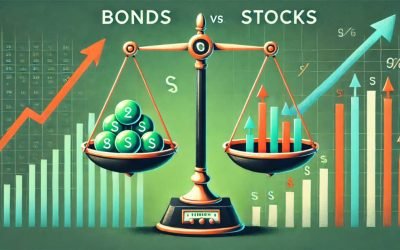Understanding Corporate Bonds: A Comprehensive Guide
Investing in corporate bonds can be a lucrative way to diversify your portfolio and generate steady income. However, it requires a solid understanding of how these financial instruments work, their benefits, and the risks involved. This article aims to provide a detailed overview of corporate bonds, covering everything from their basic structure to advanced investment strategies.
What Are Corporate Bonds?
Corporate bonds are debt securities issued by companies to raise capital. When you purchase a corporate bond, you are essentially lending money to the issuing company in exchange for periodic interest payments and the return of the bond’s face value upon maturity.
Key Features of Corporate Bonds
- Issuer: The company that issues the bond.
- Face Value: The amount the bond will be worth at maturity, also known as the principal.
- Coupon Rate: The interest rate the issuer pays to the bondholder, usually expressed as a percentage of the face value.
- Maturity Date: The date on which the bond’s principal is repaid to the bondholder.
- Credit Rating: An assessment of the issuer’s creditworthiness, which affects the bond’s interest rate and risk level.
Types of Corporate Bonds
Corporate bonds come in various forms, each with its own characteristics and risk profiles. Understanding these types can help you make informed investment decisions.
Investment-Grade Bonds
These bonds are issued by companies with high credit ratings, indicating a lower risk of default. They offer lower yields compared to high-yield bonds but are considered safer investments.
High-Yield Bonds
Also known as junk bonds, these are issued by companies with lower credit ratings. They offer higher yields to compensate for the increased risk of default.
Convertible Bonds
These bonds can be converted into a predetermined number of the issuing company’s shares. They offer the potential for capital appreciation in addition to interest income.
Callable Bonds
These bonds can be redeemed by the issuer before the maturity date, usually at a premium. This feature allows issuers to refinance debt if interest rates decline.
How to Evaluate Corporate Bonds
Before investing in corporate bonds, it’s crucial to evaluate their potential risks and returns. Here are some key factors to consider:
Credit Ratings
Credit rating agencies like Moody’s, S&P, and Fitch provide ratings that reflect the issuer’s creditworthiness. Higher ratings indicate lower risk but also lower yields.
Yield to Maturity (YTM)
YTM is the total return anticipated on a bond if held until it matures. It considers the bond’s current market price, face value, coupon interest rate, and time to maturity.
Interest Rate Risk
Bonds are sensitive to changes in interest rates. When rates rise, bond prices typically fall, and vice versa. Understanding this relationship can help you manage interest rate risk.
Company Financials
Review the issuing company’s financial statements, including income statements, balance sheets, and cash flow statements, to assess its financial health and ability to meet debt obligations.
Benefits of Investing in Corporate Bonds
Corporate bonds offer several advantages that make them an attractive investment option:
- Steady Income: Bonds provide regular interest payments, offering a predictable income stream.
- Diversification: Adding bonds to your portfolio can reduce overall risk by diversifying your investments.
- Capital Preservation: Bonds are generally less volatile than stocks, making them a safer investment for preserving capital.
- Potential for Capital Gains: If interest rates fall, bond prices may rise, allowing you to sell them at a profit.
Risks Associated with Corporate Bonds
While corporate bonds can be a valuable addition to your investment portfolio, they are not without risks:
- Credit Risk: The risk that the issuer will default on interest or principal payments.
- Interest Rate Risk: The risk that rising interest rates will cause bond prices to fall.
- Liquidity Risk: The risk that you may not be able to sell the bond easily at a fair price.
- Inflation Risk: The risk that inflation will erode the purchasing power of the bond’s interest payments and principal.
How to Buy Corporate Bonds
There are several ways to purchase corporate bonds, each with its own advantages and disadvantages:
Direct Purchase
You can buy bonds directly from the issuer during the initial offering or from other investors in the secondary market. This method allows you to choose specific bonds that meet your investment criteria.
Bond Funds
Bond funds pool money from multiple investors to purchase a diversified portfolio of bonds. This option provides instant diversification and professional management but comes with management fees.
Exchange-Traded Funds (ETFs)
Bond ETFs trade on stock exchanges like individual stocks. They offer the benefits of diversification and liquidity but may also have management fees.
Tax Considerations
Understanding the tax implications of corporate bond investments is essential for maximizing your after-tax returns:
- Interest Income: Interest payments from corporate bonds are generally subject to federal and state income taxes.
- Capital Gains: If you sell a bond for more than its purchase price, the profit is subject to capital gains tax.
- Tax-Advantaged Accounts: Holding bonds in tax-advantaged accounts like IRAs can help defer or eliminate taxes on interest income and capital gains.
Strategies for Investing in Corporate Bonds
Developing a well-thought-out strategy can help you achieve your investment goals while managing risks:
Laddering
This strategy involves purchasing bonds with different maturities to spread out interest rate risk and provide a steady stream of income.
Barbell Strategy
This approach involves investing in short-term and long-term bonds while avoiding intermediate maturities. It aims to balance the higher yields of long-term bonds with the liquidity of short-term bonds.
Active Management
Active bond investors frequently buy and sell bonds to take advantage of market opportunities and changes in interest rates. This strategy requires a deep understanding of the bond market and can be time-consuming.
Case Study: Successful Corporate Bond Investment
Consider the example of an investor who purchased investment-grade corporate bonds from a well-established company. By carefully evaluating the company’s financial health, credit rating, and market conditions, the investor was able to secure a steady income stream and achieve capital gains when interest rates declined.
Conclusion

Investing in corporate bonds can be a rewarding way to diversify your portfolio and generate steady income. By understanding the different types of bonds, evaluating their risks and returns, and developing a sound investment strategy, you can make informed decisions that align with your financial goals. While corporate bonds offer several benefits, it’s essential to be aware of the associated risks and tax implications. With careful planning and research, you can successfully navigate the corporate bond market and achieve your investment objectives.
Q&A Section
Q1: What are corporate bonds?
A1: Corporate bonds are debt securities issued by companies to raise capital. Investors who purchase these bonds lend money to the issuing company in exchange for periodic interest payments and the return of the bond’s face value upon maturity.
Q2: What are the key features of corporate bonds?
A2: Key features include the issuer, face value, coupon rate, maturity date, and credit rating. These elements determine the bond’s risk and return profile.
Q3: How can I evaluate the risk of a corporate bond?
A3: You can evaluate risk by examining the bond’s credit rating, yield to maturity, interest rate risk, and the financial health of the issuing company.
Q4: What are the benefits of investing in corporate bonds?
A4: Benefits include steady income, diversification, capital preservation, and potential for capital gains. However, it’s essential to weigh these against the associated risks.
Q5: What strategies can I use for investing in corporate bonds?
A5: Common strategies include laddering, the barbell strategy, and active management. Each strategy has its own advantages and is suited to different investment goals and risk tolerances.
Here are some excellent guides on corporate bonds that you can explore:
- NerdWallet – Understanding Corporate Bonds & How to Buy Them: This article offers a clear overview of how corporate bonds work, explaining the risks and benefits, as well as details on bond maturity, interest rates, and credit ratings. It’s great for investors looking to diversify their portfolio with bonds, and it breaks down complex concepts in a beginner-friendly way (NerdWallet: Finance smarter).
- Investopedia – Corporate Bonds: Definition and How They’re Bought and Sold: This guide is comprehensive, detailing everything from what corporate bonds are to how they are traded. It also touches on key factors such as bond ratings, credit spreads, and the differences between corporate bonds and other forms of investments, such as stocks (Investopedia).
- SoFi – A Guide to Corporate Bonds and How They Work: SoFi’s guide covers the basics of corporate bonds, including terms like par value, coupon rate, and maturity. It also provides a balanced view of the pros and cons, with a focus on the different types of bonds and risk factors that investors need to consider (SoFi).
- Hennion & Walsh – Corporate Bonds 101: A Guide for Discerning Investors: This article is perfect for investors looking for a deep dive into the role of credit ratings in bond investments. It explains how credit ratings affect corporate bonds’ demand, pricing, and yields, and discusses what happens in case of a default (Hennion & Walsh).
These resources will provide a well-rounded understanding of corporate bonds for anyone looking to start investing or expand their knowledge in this area.















 How to trade CFD? (00:49)
How to trade CFD? (00:49) How to trade binary options*? (01:22)
How to trade binary options*? (01:22) Forex. How to start? (01:01)
Forex. How to start? (01:01)